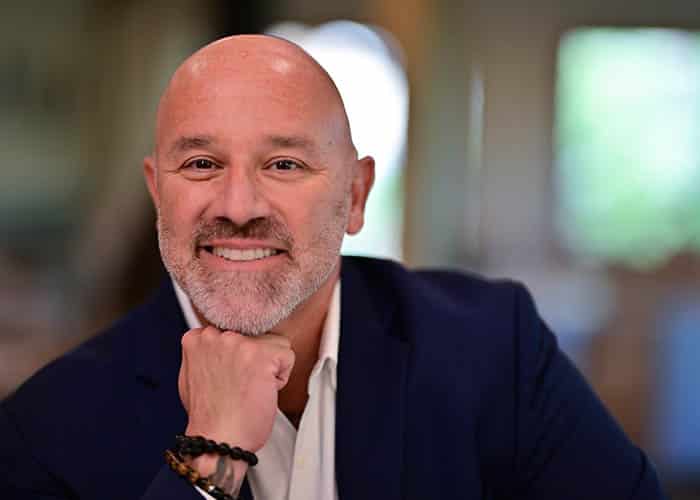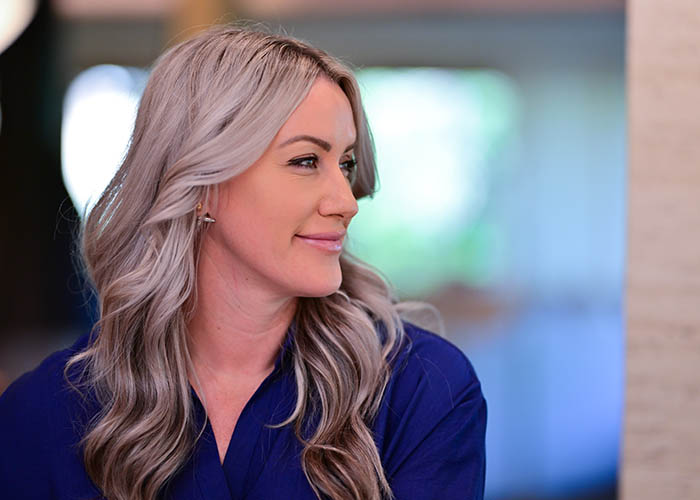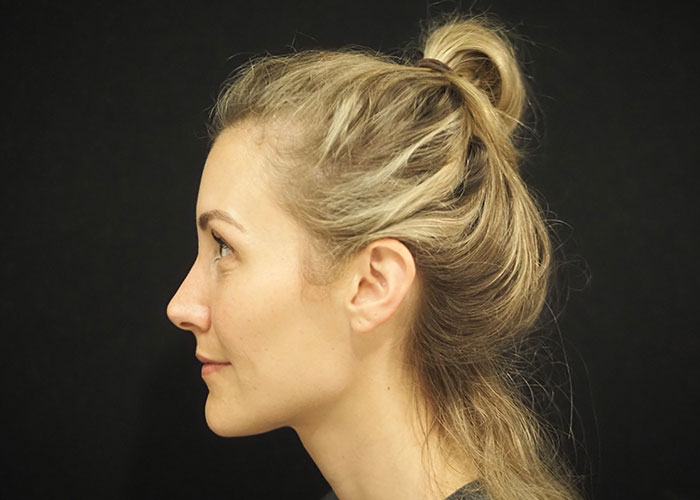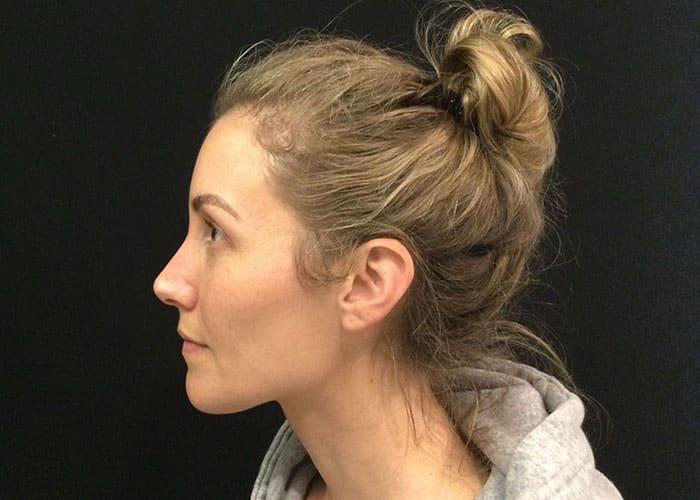Jaw Contouring
Jaw & Chin

Sculpt & Define Your Facial Harmony.
Looking for a sharper jawline or a more balanced profile? Jawline surgery refines your facial structure for a sculpted and aesthetically pleasing look. Dr. Sarah Saxon, a renowned facial plastic surgeon, offers personalized techniques to achieve your desired results.
Improve Your Jawline & Facial Contours

Jawline surgery reshapes the jaw for a more defined and symmetrical appearance. Known for its popularity among prominent Korean pop stars, this treatment addresses the bone structure and the masseter muscle of the jaw. It addresses concerns like a wide jaw, particularly at the back or front near the chin.
The procedure can involve various approaches, such as Botox injections to shrink the masseter muscle or surgical interventions to alter the bone structure, ensuring a sleek and aesthetically pleasing facial silhouette.
How Is Jawline Surgery Performed?

A wide jawline can result from multiple factors such as an enlarged masseter, wide bone structure, and skin laxity. Dr. Saxon will evaluate all of these causes and give a customized plan for your particular anatomy.
To perform jawline surgery, incisions are made inside the mouth to gain access to the mandible bone. From there, the bone can be reshaped by sculpting the bone with specialized instrumentation to narrow the contour. Dramatic results can be achieved safely without making cuts in the bone or using plates and screws.
Sometimes, removing bone from the jawline can cause some degree of skin laxity. Swelling subsides enough after about 6 months to determine whether skin tightening is necessary to optimize your results.
Jawline Surgery Corrects
- Wide jaw at the back near the angle
- Prominent jaw in the front near the chin
- Enlarged masseter muscle
- Asymmetrical jawline
- Sagging or loose skin around the jaw
- Excess fat deposits along the jawline
- Weak or undefined jawline structure
Your Jawline Surgery Plan
Neuromodulators
Neuromodulators like Botox are non-surgical treatments used in jaw contouring. Dr. Saxon carefully injects Botox into the masseter muscle, which is responsible for the width of the jaw near the back.
Once administered, the neurotoxin causes the muscle fibers to relax and shrink, resulting in a more refined and narrower jawline. This technique offers a non-invasive approach to achieving a sculpted facial appearance. The results last for 3 to 4 months.
Jawline Surgery
Jawline surgery is a surgical approach to reshaping the jawbone for a more defined look. Dr. Saxon makes incisions inside the mouth to access the bone, following which she makes strategic cuts to sculpt the jawbone. This can involve removing or altering parts of the bone to achieve the desired contour. Dr. Saxon performs preoperative CT scans and other tests to ensure optimal precision and safety during the procedure.
Structural Neck Lift
A structural neck lift is a surgical procedure to address sagging skin and muscle laxity in the neck and jawline area. It also includes removing fat deep into the muscles, which can be a genetic cause of a double chin. By making incisions discreetly placed behind the ears and sometimes under the chin, Dr. Saxon can tighten and remove excess skin and fat and reposition underlying tissues. This results in a smoother, firmer neck and a more defined jawline, enhancing the overall contour and profile of the face.FaceTite
FaceTite is a minimally invasive procedure that utilizes radiofrequency energy to tighten and contour the skin around the jawline. A small cannula is inserted beneath the skin, emitting focused RF energy to heat the underlying tissues. This stimulates collagen production and contracts the skin, resulting in a firmer, more defined jawline and neck area. FaceTite offers a non-surgical alternative to achieve a sculpted appearance with reduced downtime.Jawline Surgery Preparation:
- Consult with Dr. Saxon to discuss your goals and expectations.
- Undergo any necessary preoperative tests or evaluations.
- Avoid taking medications that can increase bleeding, such as aspirin.
- Stop smoking at least four weeks before the procedure to promote better healing.
- Arrange for someone to drive you home post-surgery and assist you during recovery.
- Follow any specific dietary or medication guidelines provided by Dr. Saxon.
- Prepare a recovery area at home with ice packs, soft foods, and pain medications.
The Recovery Process

After jawline surgery, you may notice considerable swelling, primarily due to the enlargement of the masseter muscle along the jaw’s edge. Dr. Saxon will give steroids to help with swelling and provide specific aftercare instructions, such as using a special mouthwash to prevent bacterial buildup in the mouth’s crevices. You can resume brushing your teeth as soon as you feel comfortable. We recommend doing gua sha lymphatic massage at home or in the office to help with swelling during the first few weeks. While you might observe some immediate changes, the final results generally take about 1 year to appear.
Jaw Contouring Aftercare:
- Follow Dr. Saxon’s post-operative instructions.
- Apply cold compresses to reduce swelling and discomfort.
- Avoid strenuous activities and heavy lifting for the recommended period.
- Consume soft foods and liquids to minimize strain on the jaw.
- Use a special mouthwash to prevent bacterial buildup in the mouth.
- Wear a compression garment continuously for the first week and intermittently for two weeks.
- Keep the incision areas clean and dry.
- Refrain from smoking to promote better healing and reduce complications.
- Attend all follow-up appointments to monitor your healing progress.
- Report any unusual symptoms or concerns to Dr. Saxon immediately.
- Limit exposure to direct sunlight and always use sunscreen to protect healing skin.
- Stay hydrated and maintain a balanced diet to support recovery.
Jawline Surgery FAQs
How long does the jawline surgery procedure take?
Is jawline surgery painful?
Are the results of jaw contouring permanent?
Will there be visible scars after the jawline surgery procedure?
How soon can I return to work after jaw contouring?
Are there any risks associated with jaw contouring?
- Brow Bone Reduction, Facelift and Necklift, Facial Implants, Hairline Lowering, Jaw and Chin Contouring, Lip Lift, Rhinoplasty
Top Surgical Procedures That Can Redefine Your Side Profile When most people think about their appearance, they focus on what
- Facelift and Necklift, Facetite and EmbraceRF, Jaw and Chin Contouring
How to Get a Better Jawline We all admire a sharp, defined jawline – it frames the face and exudes
- Jaw and Chin Contouring
Jaw Surgery Recovery Thinking about jawline surgery? Whether you’re considering sliding genioplasty, jaw contouring, or a combination of both, you’re
- Dermal Fillers, Facial Implants, Jaw and Chin Contouring
Non-Surgical Jaw Augmentation vs. Jaw Implants When it comes to achieving a defined, sculpted jawline, there are two primary options:
- Facial Implants, Jaw and Chin Contouring
A well-proportioned chin is an essential feature of a balanced facial profile. When the chin is underdeveloped or set back,

